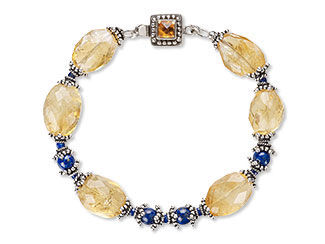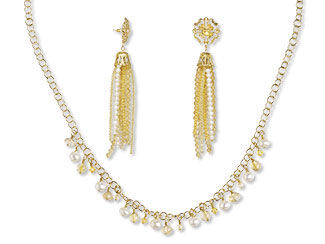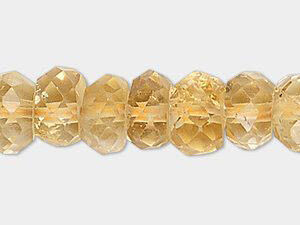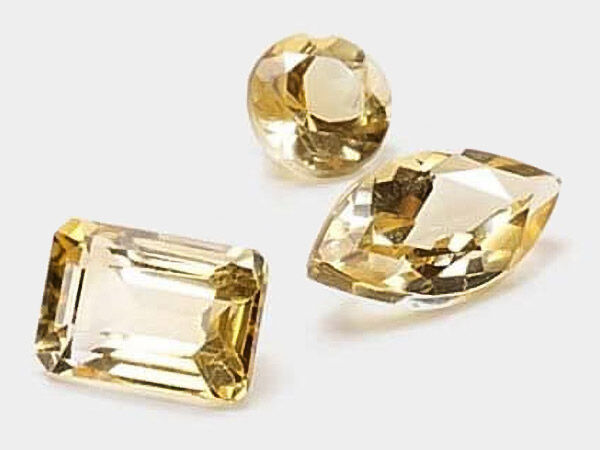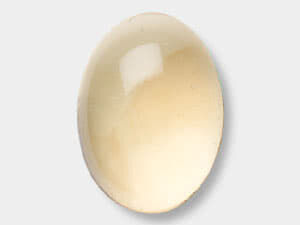Citrine Meaning and Properties
History of Citrine?
Its name is derived from the Latin word citrina because of its pale yellow citrus color (due to its iron content). From the earliest times, citrine was called the "sun stone" and believed to hold sunlight, offering protection from snakebites. The stone’s golden hue linked it to wealth and prosperity, earning it the nickname merchant’s stone. To the Romans, it was associated with Mercury, the messenger god, and commonly used to carve intaglios.
Watch this video to learn more about the history of the merchant's stone, its proposed metaphysical benefits, and its role in modern gem marketing.

What are the Metaphysical Properties of Citrine?
Citrine meaning is often connected to joy, abundance, and positivity. This golden gemstone is known as the success stone, the merchant’s stone and the money stone—each name reflecting its reputation for attracting prosperity and uplifting energy. Citrine meaning also ties into its symbolism as the November birthstone and its association with the zodiac sign Scorpio (Oct. 23 – Nov. 21). Believed to radiate sun-like warmth, citrine is thought to brighten moods and inspire a more optimistic outlook.
This vibrant yellow gem is linked with personal power, motivation and creativity. Many wearers and designers believe citrine promotes emotional well-being, attracts prosperity and encourages positive communication.
Black onyx jewelry is frequently paired with citrine to create an energetic balance—uniting grounding strength with uplifting brightness.
What Chakra is Citrine?
Citrine is strongly associated with the solar plexus chakra, the energetic center of personal power, confidence and clarity. In chakra traditions, chakras are believed to be spinning energy centers within the body that influence emotional, physical and spiritual well-being. Each chakra corresponds to a specific area and color—citrine’s warm yellow resonates with the solar plexus chakra, believed to energize and clear blockages in this area.
Solar Plexus Chakra (Manipura) - Yellow
- Location: navel (belly button)
- Represents: personal power; anxiety; forming opinions; fear; introversion; personal control
- Emotional issues: self-image; self-confidence; self-worth; expansiveness; transitions from simple emotions to complex ones
- Spiritual issues: growth; spiritual progress
- Physical issues: metabolism; digestion; energy; pancreatic troubles
- Gemstones: amber, citrine, yellow calcite, tigereye
Wearing chakra bracelets featuring citrine can support mindfulness, self-esteem and emotional resilience. To dive deeper into gemstone and chakra connections, check out this guide: Chakras and Their Gemstones.
Black onyx jewelry is also used across chakra practices for grounding energy, making it a complementary addition to citrine in chakra bracelet designs.
What is Citrine Made From?
Citrine is a macrocrystalline form of quartz, like amethyst, aventurine, and rose quartz. Composed of silicon dioxide (SiO₂), it forms in igneous and metamorphic rocks, often as crystal veins.
Natural citrine is rare; most on the market is heat-treated amethyst or smoky quartz. Brazilian amethyst turns yellow at 878°F, while smoky quartz shifts color between 572°F–752°F. These heat-treated stones may show a reddish tint and are valued for their vibrant appearance.
Gem-quality citrine is mined in Brazil, Madagascar, Russia, the U.S. and several European countries. It is often confused with yellow topaz or tourmaline but is uniquely durable with a Mohs hardness of 7.
- Mineral Information: Microcrystalline quartz
- Chemical Composition: SiO2
- Color: Golden yellow to deep yellow and yellow-orange
- Hardness: 7 (Mohs)
- Specific Gravity: 2.65
- Refractive Index: 1.544 - 1.553
How Do You Clean Citrine?
Citrine can be safely cleaned with warm, soapy water. It is usually safe to use ultrasonic cleaners unless the stone is dyed or fracture-filled. Avoid steam cleaning and intense heat, as abrupt temperature changes can cause fractures or fading.
Prolonged light exposure may diminish citrine's color. Chemicals such as hydrofluoric acid, ammonium fluoride, or alkaline solutions can also damage the stone.
Citrine FAQ
Where is citrine typically found or mined around the world?
Most natural citrine is mined in Brazil, which is the largest supplier globally. Other notable sources include Bolivia, Spain, Madagascar, Russia and the United States (particularly in Colorado and North Carolina). Some citrine is also heat-treated amethyst or smoky quartz, which often originates from the same regions.
What is the world's largest faceted citrine?
The world's largest faceted citrine is known as the "Malaga" and weighs an astonishing 20,200 carats (over 8 pounds). This gemstone is on display at the Programa Royal Collections in Spain and showcases the brilliance and clarity citrine can achieve at scale.
What are the most popular shapes for citrine jewelry?
Citrine is commonly cut into oval, round, pear, emerald, and cushion shapes, with facets that enhance its natural brilliance. These cuts are popular in rings, pendants and earrings. Checkerboard cuts and fantasy cuts are also favored for high-impact designs.
How should citrine jewelry be stored?
Store citrine jewelry in a soft-lined box or pouch, away from other gemstones that could scratch it. Keep it out of prolonged sunlight, as citrine can fade over time with UV exposure. Avoid exposure to harsh chemicals and clean it with mild soap, warm water and a soft brush.
Designing with Citrine
The sunny glow of citrine pairs beautifully with gold-tone findings and other warm-toned beads. Combine citrine with green agate, peridot, or yellow fluorite for earthy palettes, or contrast it with garnet for drama. A soft pastel look can be achieved by using aquamarine and light amethyst.
Refresh your jewelry line with a simple citrine bracelet using faceted beads, gold rondelles and a hammered toggle clasp.
A Few Design Inspirations to Get You Started
Refresh your jewelry lines with this joyous and simple citrine bracelet. Patti shows you how, using faceted citrine beads, gold-tone rondelles and a hammered metal toggle clasp to finish out the look. Watch this video and get inspired!

Shop for Citrine
**Please note that all metaphysical or healing properties listed are collected from various sources. This information is offered as a service and not meant to treat medical conditions. Fire Mountain Gems and Beads® does not guarantee the validity of any of these statements.
How did you like this resource? Your feedback helps us provide resources that matter to you most.
Copyright Permissions
All works of authorship (articles, videos, tutorials and other creative works) are from the Fire Mountain Gems and Beads® Collection, and permission to copy is granted for non-commercial educational purposes only. All other reproduction requires written permission. For more information, please email copyrightpermission@firemtn.com.


